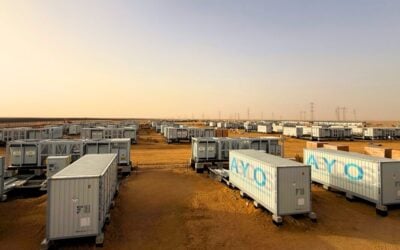From 10GW of battery storage expected to be deployed in the US over the next two years, more than 60% will be installed with solar PV, according to the US Energy Information Administration (EIA).
The EIA conducts surveys to collect statistics on existing and planned generators and associated equipment at power plants, of 1MW or more nameplate capacity. The independent group is an agency of the US Federal Statistical System.
Enjoy 12 months of exclusive analysis
- Regular insight and analysis of the industry’s biggest developments
- In-depth interviews with the industry’s leading figures
- Annual digital subscription to the PV Tech Power journal
- Discounts on Solar Media’s portfolio of events, in-person and virtual
In reporting its most recent monthly stats, the group noted that 3.1GW of battery storage was added in the US during 2021. This was a considerable increase on 2020, when cumulative installed capacity by the end of that year was found by EIA to be 1,650MW.
It’s an even more phenomenal rise when considering that installed base was about 100MW a decade ago in 2012 and crossed the 1GW line only in 2019. Over the next two years, another 10GW is expected to be added across the country.
When installed together at the same time and meeting certain conditions on charging, solar PV and battery storage can qualify for the investment tax credit (ITC), which lowers the capital cost of investment.
This has been a powerful driver for solar-plus-storage in the US but has not applied to standalone energy storage, which does not qualify for the ITC without PV. Industry groups and advocates continue to lobby for the inclusion of storage in the ITC, as well as a direct-pay option to unlock ITC benefits more quickly and simply.
The falling costs of battery storage have also been cited as a driver for activity, albeit at the moment a combination of shipping delays, high demand from the EV sector and raw materials price shocks are among factors arresting the sharp-trajectories in cost reduction batteries have enjoyed for the last 10 years.
Industry battles supply chain uncertainty
Industry sources have commented that they see many of the issues — particularly those relating to the COVID-19 pandemic — resolving in the next few months. Some have also changed strategies, with energy storage technology provider Fluence recently deciding to include raw material index-based pricing in contracts.
Fluence and others are also seeking to lock in long-term supply contracts and increased production of batteries in North America and Europe as planned over the next few years will undoubtedly change the landscape further.
Over the next two years, 41GW of utility-scale solar PV plants and 10GW of battery storage are planned by developers and operators of power plants, EIA said, which is 60% of the entire expected 85GW of capacity additions over the 2022-2023 timeframe.
Texas, California and New York will be the leading states for solar and battery storage in that time, between them accounting for 27GW of new additions. The US will also see 16GW of natural gas and 15GW of wind power installed in the next two years.
Sister site PV Tech reported that EIA expects 22GW of new utility-scale solar PV online in the US in 2022. The sector deployed 13GW in 2021.
EIA’s reported numbers for 2021 battery storage deployments are lower than the approximately 4.2GW of battery storage capacity found to have been added to the grid during last year in research by BloombergNEF, as recently reported on this site.
BloombergNEF’s report, produced for The Business Council for Sustainable Energy, accounted for all segments of the storage market, from residential and commercial to industrial and utility-scale.
Meanwhile a similar year-end 2021 report from the American Clean Power Association found 2.6GW of utility-scale battery energy storage system (BESS) deployments in the US during the year.
You can keep up with the monthly and annual generator and electricity sector reports and other information from the EIA at its website here.






